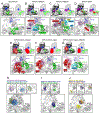Posing the APC/C E3 Ubiquitin Ligase to Orchestrate Cell Division
- PMID: 30482618
- PMCID: PMC6340778
- DOI: 10.1016/j.tcb.2018.09.007
Posing the APC/C E3 Ubiquitin Ligase to Orchestrate Cell Division
Abstract
The anaphase promoting complex/cyclosome (APC/C) E3 ligase controls mitosis and nonmitotic pathways through interactions with proteins that coordinate ubiquitylation. Since the discovery that the catalytic subunits of APC/C are conformationally dynamic cullin and RING proteins, many unexpected and intricate regulatory mechanisms have emerged. Here, we review structural knowledge of this regulation, focusing on: (i) coactivators, E2 ubiquitin (Ub)-conjugating enzymes, and inhibitors engage or influence multiple sites on APC/C including the cullin-RING catalytic core; and (ii) the outcomes of these interactions rely on mobility of coactivators and cullin-RING domains, which permits distinct conformations specifying different functions. Thus, APC/C is not simply an interaction hub, but is instead a dynamic, multifunctional molecular machine whose structure is remodeled by binding partners to achieve temporal ubiquitylation regulating cell division.
Keywords: E3 ligase; anaphase promoting complex/cyclosome; cell division; cryo-electron microscopy; mitosis; ubiquitin.
Copyright © 2018 Elsevier Ltd. All rights reserved.
Figures




Similar articles
-
RING E3 mechanism for ubiquitin ligation to a disordered substrate visualized for human anaphase-promoting complex.Proc Natl Acad Sci U S A. 2015 Apr 28;112(17):5272-9. doi: 10.1073/pnas.1504161112. Epub 2015 Mar 30. Proc Natl Acad Sci U S A. 2015. PMID: 25825779 Free PMC article.
-
Ubiquitin chain-elongating enzyme UBE2S activates the RING E3 ligase APC/C for substrate priming.Nat Struct Mol Biol. 2020 Jun;27(6):550-560. doi: 10.1038/s41594-020-0424-6. Epub 2020 May 11. Nat Struct Mol Biol. 2020. PMID: 32393902 Free PMC article.
-
Structure of an APC3-APC16 complex: insights into assembly of the anaphase-promoting complex/cyclosome.J Mol Biol. 2015 Apr 24;427(8):1748-64. doi: 10.1016/j.jmb.2014.11.020. Epub 2014 Dec 6. J Mol Biol. 2015. PMID: 25490258 Free PMC article.
-
Structural interconversions of the anaphase-promoting complex/cyclosome (APC/C) regulate cell cycle transitions.Curr Opin Struct Biol. 2020 Apr;61:86-97. doi: 10.1016/j.sbi.2019.11.010. Epub 2019 Dec 25. Curr Opin Struct Biol. 2020. PMID: 31864160 Review.
-
Functional characterization of Anaphase Promoting Complex/Cyclosome (APC/C) E3 ubiquitin ligases in tumorigenesis.Biochim Biophys Acta. 2014 Apr;1845(2):277-93. doi: 10.1016/j.bbcan.2014.02.001. Epub 2014 Feb 22. Biochim Biophys Acta. 2014. PMID: 24569229 Free PMC article. Review.
Cited by
-
Role of circRNA in E3 Modification under Human Disease.Biomolecules. 2022 Sep 18;12(9):1320. doi: 10.3390/biom12091320. Biomolecules. 2022. PMID: 36139159 Free PMC article. Review.
-
Design of linked-domain protein inhibitors of UBE2D as tools to study cellular ubiquitination.bioRxiv [Preprint]. 2024 Sep 2:2024.09.02.610852. doi: 10.1101/2024.09.02.610852. bioRxiv. 2024. PMID: 39282319 Free PMC article. Preprint.
-
Design, Synthesis, and Biological Evaluation of Apcin-Based CDC20 Inhibitors.ACS Med Chem Lett. 2022 Jan 18;13(2):188-195. doi: 10.1021/acsmedchemlett.1c00544. eCollection 2022 Feb 10. ACS Med Chem Lett. 2022. PMID: 35178174 Free PMC article.
-
PP1 promotes cyclin B destruction and the metaphase-anaphase transition by dephosphorylating CDC20.Mol Biol Cell. 2020 Oct 1;31(21):2315-2330. doi: 10.1091/mbc.E20-04-0252. Epub 2020 Aug 5. Mol Biol Cell. 2020. PMID: 32755477 Free PMC article.
-
Adaptation to spindle assembly checkpoint inhibition through the selection of specific aneuploidies.Genes Dev. 2023 Mar 1;37(5-6):171-190. doi: 10.1101/gad.350182.122. Epub 2023 Mar 1. Genes Dev. 2023. PMID: 36859339 Free PMC article.
References
-
- King RW et al. (1996) How proteolysis drives the cell cycle. Science 274 (5293), 1652–9. - PubMed
-
- King RW et al. (1995) A 20S complex containing CDC27 and CDC16 catalyzes the mitosis-specific conjugation of ubiquitin to cyclin B. Cell 81 (2), 279–88. - PubMed
-
- Irniger S et al. (1995) Genes involved in sister chromatid separation are needed for B-type cyclin proteolysis in budding yeast. Cell 81 (2), 269–78. - PubMed
Publication types
MeSH terms
Substances
Grants and funding
LinkOut - more resources
Full Text Sources
Other Literature Sources
Molecular Biology Databases

